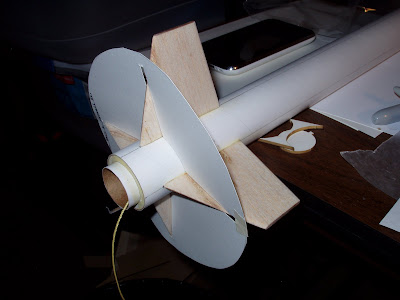I was going to come to the defense of CA as a fin adhesive, but Kevin (troj) beat me to it. I follow the same method that he outlined. The key to using CA is to use
THICK CA, either the gap-filling variety (like Bob Smith Industries Insta-Cure+, which is what I mostly use) or the slow-curing kind (e.g., Bob Smith Industries Maxi-Cure). You won't find these varieties at your local stationary store or hardware store - you will almost always only find them in hobby shops. The good news is that they are not expensive. Buy them in small 1/2 oz. or 3/4 oz. bottles at first. It is possible to save money by purchasing the larger bottles of it, especially if you know that you will be using it a lot, but these require special care and storage to insure that the CA doesn't harden in the bottle long before you use it up. (This has been the subject of more than one discussion thread on this forum.)
The other key is to use another adhesive in conjunction with the CA,
as Kevin discussed. On some very lightweight models, I have created joint reinforcements (fin fillets) with BSI Maxi-Cure CA, which I then hardened with Insta-Set accelerator. Otherwise, I use either yellow carpenter's glue or 30-minute epoxy.
There is some great advice in the previous posts about getting fins aligned straight. I want to especially point out
Micromeister's advice about getting the fins properly spaced around the tube. His flat marking guides are probably the best overall method for marking the tube in the right places for fins. Unfortunately, I have trouble keeping the tube precisely centered and steady while I stand it on its end and place marks around the circumference for the fins when I use this method. Wrap-around guides do need to be properly sized for the tube in order to produce accurate results, but that is the method that I use. I make customized fin wrapper guides for each project using either
Gary Crowell's free VCP program or his free VCT program. Over the past couple of years, through trial and error I have compiled a list of measurements that I enter into the form to size the wrapper precisely for the body tubes sizes that I use. When the proper dimensions are plugged into it, VCP and VCT produce very accurate and precise fin marking wrappers. This process is not at all hard; if it was, I wouldn't be using it!
Once I mark the fin locations on the tube, I use a length of aluminum angle (you can buy it cheap at your local hardware store) to draw straight lines up the tube.
Charlaine's advice is very pertinent here: place each fin on the tube by aligning one side of the fin root along the drawn line. In other words, do not try to center the fin over the line - place the fin next to the line. Just make sure that you place each fin on the same side of each line (e. g., place each fin to the left of its marked line).
I don't use a physical guide to get the fins on straight and perpendicular to the tube. To align them straight, I use the aforementioned drawn lines. To get them to be perpendicular to the tube, I use a very reliable and accurate gauge - my eyeball. When in doubt, I find a reference point, such as the edge of a door or the side of a cabinet, that is vertical, straight and in the background. Then I hold the tube up and look through it until the opening at the far end is centered in the opening at the near end, and my fin is at the top. I line it up so that when the tube is perfectly horizontal (far opening is centered in near opening), when I glance up, the fin is lined up perfectly with the reference point in the background. (This is an old artist's and crafter's trick.) Using Insta-Cure+ (gap-filling CA) or Maxi-Cure (slow-curing CA) to initially bond the fin to the tube really helps here. Both of these products give me a little bit of working time to allow me to reposition the fin before they set up, but they set up fast enough that I don't have to hold up the tube for a really long time. I take my time, though, and glue one fin on at a time, and I don't rush things. I never have any trouble getting my fins on straight and perpendicular with this method.
The methods that others have described are fine too, especially if you have steady hands and deep wells of patience, and I don't mean to knock them by any means. The procedures described above are the ones that I use, though.
MarkII













